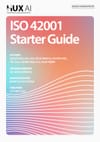⚡ Quick Summary
This guide interprets ISO/IEC 42001 as an auditable AI Management System (AIMS) and shows how to operationalize it across context, leadership, planning, support, operation, evaluation, and improvement. It contrasts ISO 42001 with the EU AI Act and NIST AI RMF, maps responsibilities across executive, data, engineering, operations, and assurance roles, and anchors everything in a step-by-step hiring-tool case (“X Corporation”). Visuals—lifecycle checkpoints, an AIMS mind map, and collaboration/RACI canvases—turn abstract clauses into implementable controls, reviews, and evidence trails. The tone is straightforward, sector-agnostic, and geared to teams preparing for internal readiness or third-party certification.
🧩 What’s Covered
- What ISO 42001 is—and isn’t. Clear positioning versus NIST AI RMF (risk vocabulary, non-certifiable) and the EU AI Act (legal obligations, enforcement). ISO 42001 is framed as a certifiable management system that auditors can verify (pp. 5–7).
- AIMS scope & lifecycle. The document defines what an AIMS governs (“in scope” AI uses, processes, responsibilities) and stresses continuous, evidence-backed management across the AI lifecycle—risk/impact assessment, KPIs, audits, and corrective action (pp. 6–8, 12–18).
- Role & responsibility matrices. A three-page matrix assigns accountabilities across governance (CAIO, Governance/Compliance), data (stewards, ML), design/engineering (PM, AI/UX/security), operations (MLOps, monitoring, incident, vendor), and assurance (TEVV, internal/external audit, documentation, continual improvement) (pp. 9–11).
- Clause-by-clause “cards.”
- Clause 4—Context: stakeholder mapping, AIMS boundaries (p. 12).
- Clause 5—Leadership: AI policy, roles, management reviews (pp. 13–14).
- Clause 6—Planning: risk criteria/thresholds, per-use risk & impact assessment, treatment plans, objectives, and controlled change (pp. 14–16).
- Clause 7—Support: resources, competence, awareness, communication, and documented information control (pp. 18–20).
- Clause 8—Operation: execute controls, versioning, monitoring & re-checks, impact assessments, traceable evidence (pp. 20–21).
- Clause 9—Performance evaluation: KPIs/dashboards, internal audit program, and management review inputs/outputs (p. 22).
- Clause 10—Improvement: nonconformity handling and continual improvement with recorded outcomes (pp. 23–24).
- End-to-end hiring use case. “X Corporation” buys a CV-ranking tool; the guide walks through GDPR/anti-discrimination alignment, human-in-the-loop decisions, fairness/accuracy thresholds (≥85% accuracy; ≥80% fairness), drift alerts, kill-switch/rollback, audits, and a documented improvement that lifts accuracy from 82%→91% while restoring fairness (pp. 8, 18, 21–27).
- Visual toolkits.
- Lifecycle checkpoints wheel and AIMS mind-map (p. 17).
- Lifecycle map (p. 25).
- Annex A: cross-role collaboration canvas and RACI for AIMS activities (pp. 30–31).
- Annex B: structured question sets to scope data/use (pp. 31–32).
💡 Why it matters?
Organizations often struggle to translate AI “principles” into audit-ready processes. This guide closes that gap by mapping ISO 42001 clauses to concrete roles, thresholds, artifacts (policies, logs, risk registers), and evidence paths. It shows how to run a PDCA loop for AI: set policy and objectives, assess and treat risk, instrument monitoring, audit, and drive corrective action—while maintaining legal alignment (e.g., GDPR) and readiness for certification. Teams can use the canvases and checklists to accelerate AIMS design, procurement requirements, and board-level assurance.
❓ What’s Missing
- Deeper audit artifacts. Examples of filled-in risk registers, internal audit checklists, and management review minutes would help first implementations.
- Metrics catalog. The guide quotes thresholds (accuracy/fairness) but lacks a reusable KPI library with formulas and sampling plans by use case.
- Supply-chain detail. Vendor assessment and model-card/documentation requirements are mentioned but not expanded into templates.
- Generative-AI specifics. Safety/eval patterns (prompt/finetune data governance, content risk taxonomies, red-teaming) are not deeply elaborated.
- EU AI Act mappings. High-level alignment is noted; a control-by-control crosswalk (Annex) would be valuable for dual compliance.
👥 Best For
- Heads of AI / CAIO / Risk & Compliance leads building an AIMS and needing a common language with engineering and audit.
- Product, ML, and MLOps teams seeking clause-aligned workflows and evidence requirements.
- Procurement & vendor-risk managers creating ISO 42001-aware RFPs and supplier controls.
- Internal auditors / QA designing an audit program and conformity evidence trail.
📄 Source Details
- Title: ISO 42001 Starter Guide
- Authors: Burçin Kızılcıklı, Ege Uğur Amasya, Hayriye Anıl, İdil Kula, Nesibe Kırış Can, Onur Pişirir
- Advisor & Mentor: Işıl Selen Denemeç; Advisor & Editor: Merve Ayyüce Kızrak
- Publisher: HUX AI; Date: October 2025; Length: 35 pp.
- License: CC BY-NC 4.0 (license and disclaimer on p. 2).
- Notable visuals: Lifecycle checkpoints & AIMS map (p. 17), Lifecycle map (p. 25), Role/RACI canvases (pp. 30–31), Data & Use scoping tables (pp. 31–32).
📝 Thanks to
The authors and HUX AI team for turning a dense standard into an actionable, visually rich playbook—with special credit to the advisors/editors who sharpened clarity and usability.


